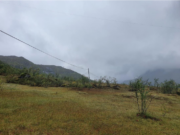Rain, poorly functioning windshield wipers and a lack of runway centerline lighting resulted in limited visual cues that led to an Airbus A320’s runway excursion at Toronto/Lester B. Pearson International Airport in 2017, the Transportation Safety Board of Canada (TSB) says.
In its final report on the accident, released Wednesday, the TSB said that the poor visibility “reduced the cues available to recognize the aircraft’s drift in time to correct the trajectory or to execute a safe go-around.”
None of the 119 passengers and six crewmembers was injured in the Feb. 25, 2017, runway excursion, which caused minor damage to the A320’s left outboard wheel and left engine cowling, the report said. The excursion came at the end of a flight from Halifax, Nova Scotia, after the airplane began deviating to the right of the runway centerline, the report said, adding that the airplane traveled nearly 2,400 ft through the grass parallel to the runway, striking five runway edge lights before returning to the pavement.
Accident investigators determined that during final approach, with the airplane less than 30 ft above ground level and lined up with the runway centerline, “a right roll command input caused the aircraft to enter a shallow right bank and start drifting to the right,” the report said.
Because of the limited visual cues, the crew had difficulty determining the airplane’s lateral position, the report added, and “the severity of the drift was not recognized until the aircraft was less than 10 feet above ground and rapidly approaching the runway edge, which left limited time to correct the aircraft’s trajectory before contacting the surface.”
The report said that after the accident, Air Canada issued additional guidance to flight crews on lateral drifts and lateral runway excursions, developed a simulator drift training scenario and began a program of inspections for windshield wiper tension.



